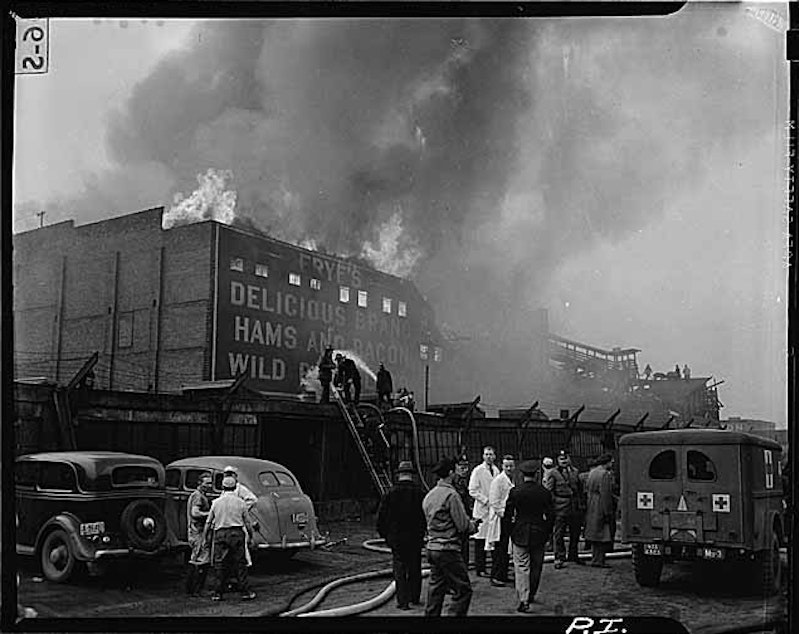70 Years Ago: Remembering The Crash Of Boeing’s Superfortress

The Boeing Dreamliner was been grounded since Jan. 16 as authorities try to sort out problems with the plane’s high tech batteries and electrical system. Meanwhile, it was 70 years ago this coming week that an earlier Boeing plane caught fire over Seattle during a test flight, causing one of the worst air disasters in the city’s history.
In the winter of 1943, Seattle was a wartime city. Soldiers and sailors thronged the sidewalks downtown, but one of the busiest places was the Boeing factory along Marginal Way South. 24 hours a day, “Rosie the Riveters” and other war workers churned out B-17 Flying Fortress bombers.
Boeing’s B-17 was already famous as a workhorse of the war in the Europe. The planes were a familiar sight on the runways at Boeing Field, and in the skies over the city.
It was around lunchtime on Feb. 18, 1943 when a woman in the Smith Tower noticed a military plane flying low over downtown, headed south. Smoke was pouring from one of the engines, and the plane was dropping fast. The woman could tell this wasn’t a B-17. This was something different. It was bigger. And, it was a secret.
Boeing had been working secretly for three years to develop a high-capacity, high-altitude bomber. The public didn’t know about it then, but eventually, the B-29 would become one of the most well-known American aircraft of World War II.
Sponsored
But on Thursday, Feb. 18, 1943, the mystery aircraft heading toward Boeing Field was one of only two B-29 prototypes in existence. And it was in trouble.
At the controls was Edmund T. Allen, the most experienced test pilot at Boeing and perhaps in the entire aviation industry. But the new plane was on fire, and this time, even the great Eddie Allen couldn’t save it.
The doomed bomber clipped power lines in Georgetown, and knocked out electricity to thousands of homes and businesses. It then smashed through the roof of the Frye Meat Packing Plant north of the runway.
The plane was loaded with fuel, and the building exploded into flames. All 11 members of the crew died in the crash. The fire also killed 20 workers in the plant and a Seattle firefighter perished battling the blaze.
It was later revealed that the crash and the loss of the flight test crew seriously threatened development of the B-29. The bomber was pivotal in Allied battle plans for the Pacific, and the delay was a major setback for the war effort.
Sponsored
By early June 1944—just over a year after the Seattle crash—the bomber saw combat for the first time, when nearly a hundred B-29’s attacked Japan.
The B-29 was in the news again when it flew a mission, now regarded as among the most controversial in history. Webley Edwards of CBS recounted how one witness described the scene on that August day in 1945 when the Superfortress dropped the atomic bomb on Hiroshima: “And the boiling continued several minutes as we watched. Then the mushroom of smoke broke off and another developed below it. This one bomb is the equivalent of a 2,000 B-29 raid.”
Over one hundred thousand people died in the atomic blasts of Hiroshima and Nagasaki. Japan surrendered less than a week later. But 70 years later, critics argue whether or not the atomic bomb was necessary. Some say Japan would have surrendered anyway.
What’s not debatable is that the B-29 program rose from the ashes of the devastating Seattle crash. The Superfortress fired the last volley of World War Two, and the first of the nuclear age and the Cold War.
Before anyone knew the bombers would play this historic role, Army production chief Gen. William Knudsen said it best when he described the B-29 this way to a Seattle audience: “War is a rock-throwing contest, and the fellow with the most rocks wins. So that’s why we’ve got to keep on building those rocks.”
